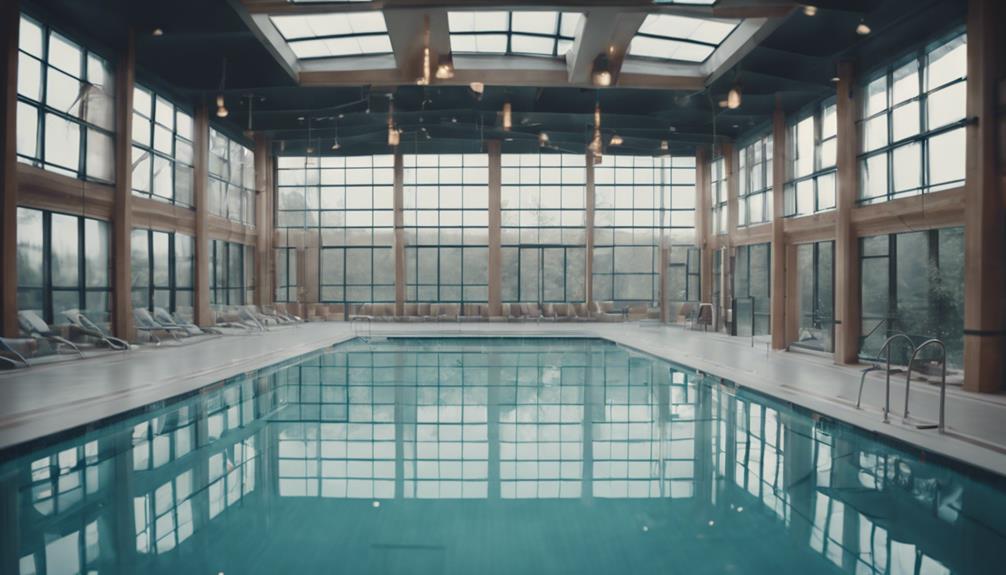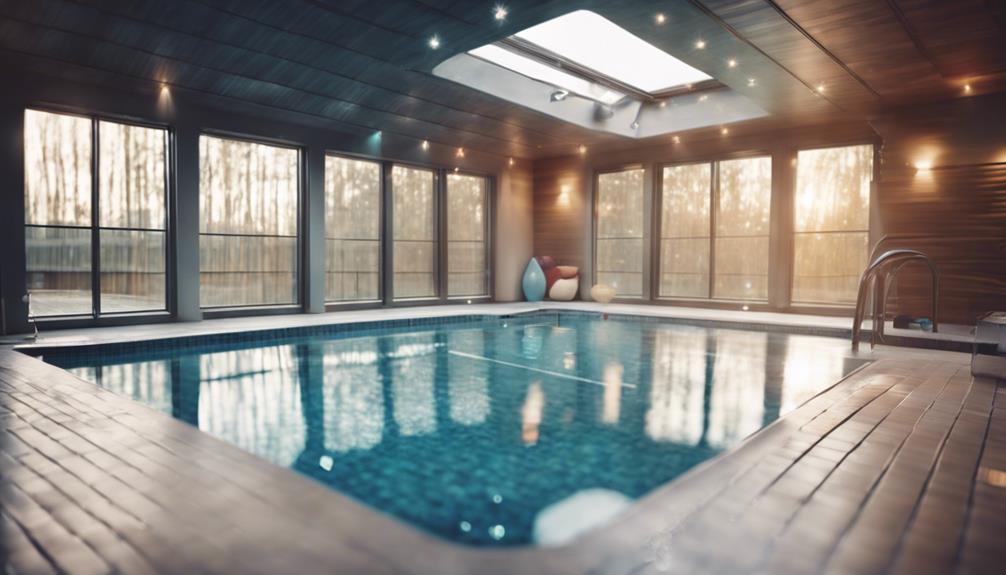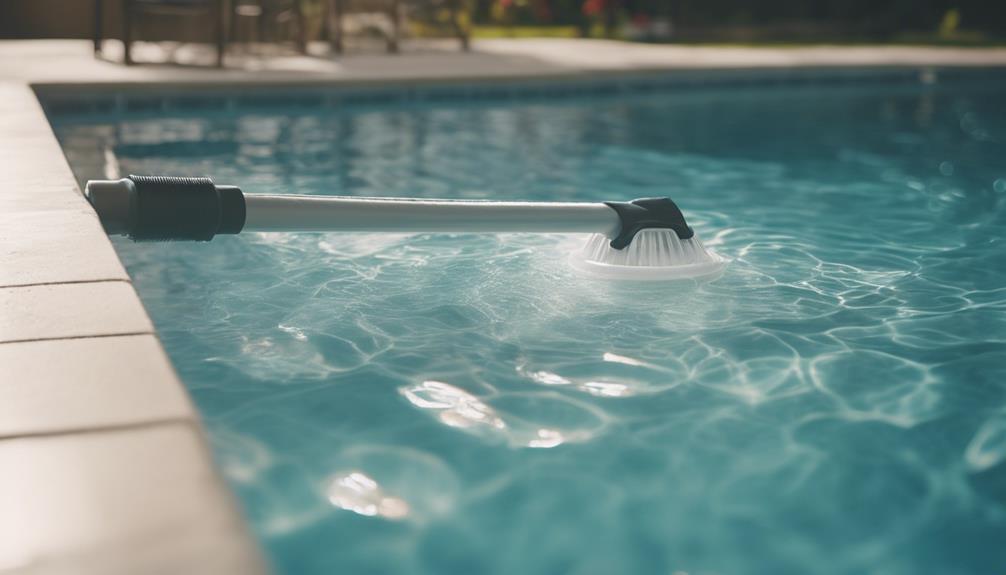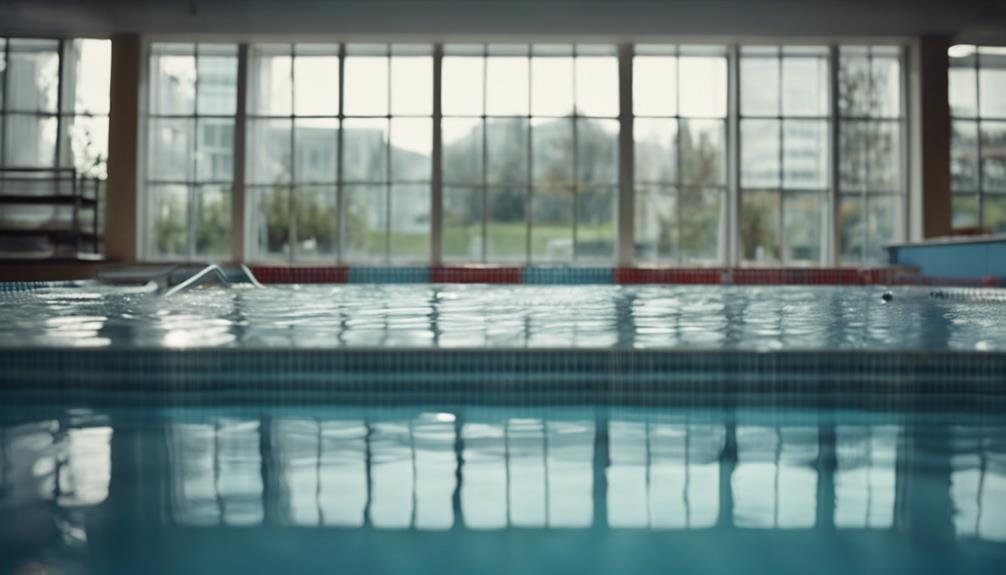To effectively heat your indoor swimming pool, consider utilizing heat pumps, dehumidification systems, pool covers, and proper ventilation. Heat pumps transfer heat from the air to the pool water, maintaining consistent temperatures regardless of external conditions. Dehumidifiers efficiently regulate water temperature and improve air quality. Pool covers assist in retaining heat, reducing heating expenses, and managing humidity levels. Ventilation controls moisture, preventing damage and enhancing air quality for a secure swimming environment. These components collaborate to establish a comfortable and energy-efficient indoor pool. Dive deeper to learn more about optimizing the heating efficiency of your indoor swimming pool.
Key Takeaways
- Heat pumps efficiently transfer heat from the air to the pool, ensuring consistent water temperatures.
- Dehumidifiers with pool heating capabilities regulate water temperature and maintain ideal humidity levels.
- Pool covers retain heat, prevent evaporation, and reduce heating costs significantly.
- Proper ventilation controls moisture, prevents mold, and improves air quality in indoor pool rooms.
- Regular maintenance, including thermostat calibration and filter cleaning, ensures optimal system performance.
Benefits of Heat Pumps
Discover the numerous benefits of heat pumps for heating indoor pools efficiently and environmentally consciously.
Pool heat pumps are a fantastic option for indoor pool heating, offering exceptional energy efficiency by transferring heat from the air to the pool water with minimal energy consumption. This method guarantees that your indoor pool maintains consistent water temperatures throughout the year, regardless of the external weather conditions outside.
Not only are heat pumps environmentally friendly, utilizing renewable energy sources like the air to heat the pool water, but they also assist in dehumidifying indoor pool rooms, reducing excess moisture and enhancing overall air quality.
Additionally, these systems are highly cost-effective, providing long-term savings on energy costs and operational efficiency. By investing in pool heat pumps, you aren't only securing a comfortable swimming experience but also contributing to a greener and more sustainable approach to indoor pool heating.
Dehumidification and Pool Heating

If you're looking to maintain ideal conditions in your indoor pool area, considering dehumidification and pool heating methods is essential.
Dehumidifiers equipped with pool water heating capabilities can efficiently regulate water temperature and reduce heating expenses by utilizing the heat produced during dehumidification.
Humidity Control Techniques
Dehumidifiers and pool heating systems play a crucial role in maintaining ideal humidity levels and air quality in indoor pool facilities. By utilizing dehumidifiers, indoor pools can effectively control humidity, preventing mold, corrosion, and ensuring comfort for swimmers.
These systems not only regulate moisture levels but also contribute to efficient heating by extracting heat from the air during dehumidification. This integrated approach not only optimizes water temperature but also safeguards against moisture-related damage.
Proper humidity control is essential for creating a pleasant and safe environment for swimmers while also enhancing air quality and reducing health risks associated with high humidity.
Investing in effective dehumidification systems is key to maintaining ideal humidity levels, preventing mold growth, and preserving the overall integrity of indoor pool facilities.
Pool Heating Methods
Efficiently combining dehumidification and pool heating systems enhances indoor pool comfort and energy efficiency. Dehumidification systems not only control humidity levels in the indoor pool room but also aid in preventing issues like mold and corrosion. Pool heating methods often incorporate dehumidifiers that can extract heat from the air, warming the pool water effectively. This integration of dehumidification and pool heating is key to achieving ideal energy savings while maintaining a pleasant indoor pool environment. By managing moisture levels, dehumidification plays a vital role in ensuring the overall performance and efficiency of indoor pools. The table below illustrates how these systems work together to regulate the pool water temperature and minimize heat loss in indoor swimming pool settings.
| Pool Heating Methods | Benefits |
|---|---|
| Dehumidification | Controls humidity levels, prevents mold and corrosion |
| Pool Heating | Warms pool water efficiently, enhances energy savings |
Importance of Pool Covers

Covering your indoor pool with a pool cover is a strategic move for both your wallet and the environment. Pool covers play a vital role in retaining heat, which leads to significant energy savings and decreased heating costs.
Covering for Heat Retention
Pool covers play an important role in reducing heating costs and maintaining ideal water temperature in indoor pools. Here's why they're essential for heat retention:
- Energy Efficiency: By preventing evaporation, pool covers can reduce heating costs by 50-70%, making them a vital solution for indoor pool heating.
- Temperature Maintenance: Indoor pools benefit from covers to retain water temperature without overusing heaters, especially in year-round pool facilities.
- Humidity Control: Pool covers help in controlling humidity levels, reducing the need for additional dehumidifiers and ventilation systems, which can further save on energy costs.
- Cost-Effective Solution: Using pool covers is highly effective at retaining heat in the water, making them an integral component of energy-efficient indoor pool heating systems.
Energy Efficiency Benefits
To enhance energy savings and maintain ideal water temperature, utilizing pool covers is essential for indoor pool owners. Pool covers play an important role in reducing energy costs by preventing evaporation, which is the primary source of heat loss for pools. By covering your indoor pool when not in use, you can greatly lower heating costs and improve energy efficiency. In fact, pool covers can decrease energy costs by 50-70%, making them a cost-effective solution for maintaining a comfortable pool temperature year-round.
Indoor pools, in particular, benefit greatly from pool covers as they help in preventing evaporation and maintaining water temperature without relying heavily on heaters. This means that you can enjoy your pool while keeping energy consumption in check.
Whether you're looking to lower heating costs, conserve energy, or make sure your pool is ready for use throughout the year, utilizing pool covers offers a range of benefits that contribute to overall energy efficiency in indoor pool environments.
Ventilation for Indoor Pools

Ensuring proper ventilation in indoor pool areas is essential for maintaining a comfortable and healthy environment by controlling humidity levels and preventing issues like mold and wood rot. Here are four key points to think about when it comes to ventilation for indoor pools:
- Moisture Control: Ventilation systems play an important role in managing the moisture generated from the pool water and air. This helps prevent the buildup of excessive humidity that can lead to mold and corrosion.
- Air Quality: Proper ventilation guarantees the circulation of fresh air, improving the overall air quality in indoor pool rooms. This is crucial for the health and comfort of swimmers and spectators.
- Dehumidification Process: Dehumidifiers are essential components of indoor pool ventilation systems. They work by cooling and condensing moisture, helping to maintain ideal humidity levels and prevent condensation issues.
- Preventing Damage: Effective ventilation is key to preventing condensation on pool surfaces, which can lead to safety hazards and damage. Maintaining a well-ventilated indoor pool area is important for a safe and enjoyable swimming experience.
Energy Efficiency Strategies

Managing energy efficiency in indoor pool facilities involves implementing strategies that can greatly reduce pool heating costs and environmental impact.
One effective method is to cover the pool when not in use, as this simple act can cut heating expenses by 50-70% by preventing water evaporation.
Utilizing solar heating systems is another vital approach to lowering energy bills, as they can substantially reduce the costs of heating an indoor pool.
Maintaining a warm temperature in the pool room is essential to minimize heat loss from the pool water, ensuring that energy is used efficiently.
Heat pump systems aren't only efficient but also environmentally friendly for heating indoor pools, offering a sustainable option for keeping the water warm.
Additionally, adjusting the pool temperature according to usage patterns can lead to more energy-efficient heating, helping you save on energy costs while still enjoying a comfortable swim.
Maintenance Tips for Pool Heating Systems

Regularly cleaning and inspecting your pool heating system components is crucial for guaranteeing efficient operation and preventing potential issues. To maintain your pool heating system effectively, consider the following maintenance tips:
- Thermostat Calibration: Check and calibrate thermostats and controls regularly to ensure precise temperature settings for ideal comfort.
- Air Filter Cleaning: Keep air filters clean and replace them as needed to prevent airflow restrictions and maintain proper system performance.
- Professional Maintenance Checks: Schedule routine professional maintenance checks to identify any potential issues early and ensure the longevity of the heating system.
- Energy Consumption Monitoring: Monitor energy consumption and heating system performance to identify inefficiencies and make necessary adjustments for cost-effective operation.
Cost-Effective Heating Solutions

To maintain a cost-effective indoor heating solution, consider implementing strategies that can help reduce energy consumption and optimize heating efficiency.
Indoor pool owners aiming to heat their pool affordably have a range of heating options to explore. Utilizing a pool cover can greatly reduce heating costs by 50-70% through preventing heat loss via evaporation.
Heat pumps offer a cost-effective and energy-efficient method by extracting heat from the air to warm the pool water. Solar heating systems harness sunlight to heat the pool water, contributing to reduced energy costs.
Maintaining a warm temperature in the pool room can aid in retaining heat in the water, potentially decreasing the need for additional heating. Additionally, ensuring proper insulation and ventilation in the pool room can further enhance cost-effective heating solutions for indoor pools.
Frequently Asked Questions
What Is the Most Efficient Pool Heating System?
For the most efficient pool heating system, consider a heat pump, solar heating, pool covers, insulation, and ventilation. Maximize energy usage by adjusting the system based on pool activity. These solutions guarantee cost-effectiveness and a comfortable swimming environment.
What's the Cheapest Way to Heat a Pool?
To heat a pool cost-effectively, cover it when not in use, maintain room warmth, and consider heat pumps. These methods help save on energy bills and reduce heating expenses, ensuring a comfortable swimming experience without breaking the bank.
What Is the Best Temperature for an Indoor Swimming Pool?
For an indoor swimming pool, the best temperature is around 78-88 degrees Fahrenheit. This range suits both exercise and relaxation. Keep users' comfort in mind and adjust based on activities to enhance your swimming experience.
Can You Put a Pool Heater Indoors?
Yes, you can place a pool heater indoors if you guarantee proper ventilation and comply with building codes. Gas and electric heaters are common options, but consult a professional to determine the best choice for your indoor swimming pool.
What are the benefits of using smart heating for indoor swimming pools compared to traditional heating solutions?
Switching to efficient swimming pool heating systems, such as smart heating, offers several advantages over traditional methods. Smart heating systems can be programmed to maintain the perfect temperature, saving energy and reducing costs. They also provide more precise control, ensuring a comfortable and consistent swimming environment for users.
Conclusion
To sum up, when it comes to heating your indoor swimming pool, utilizing heat pumps, pool covers, proper ventilation, and energy-efficient strategies is key.
By prioritizing maintenance and cost-effective solutions, you can enjoy a warm and inviting pool year-round.
So, remember to keep your pool cozy and comfortable with these efficient heating solutions, ensuring that every dip in the water is a rejuvenating and enjoyable experience.










